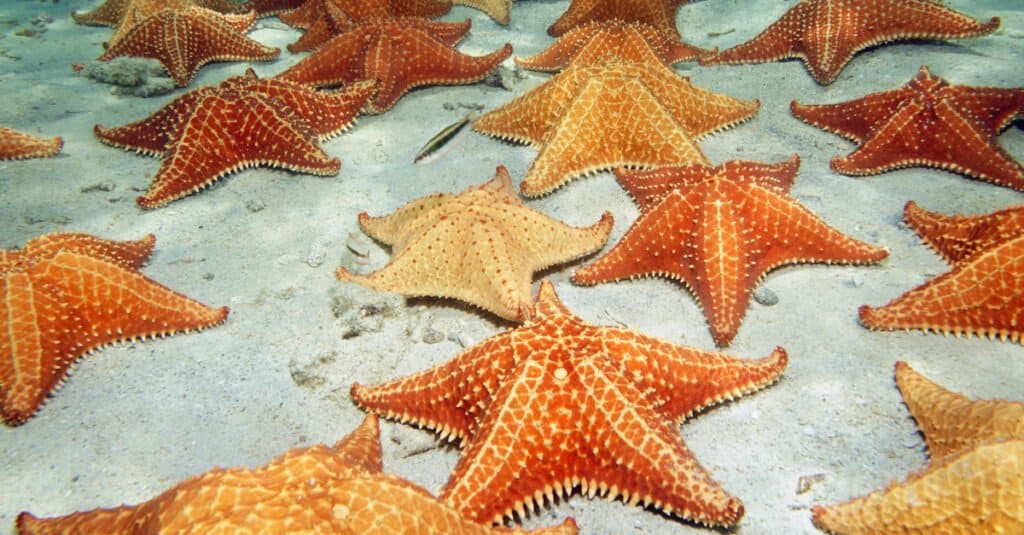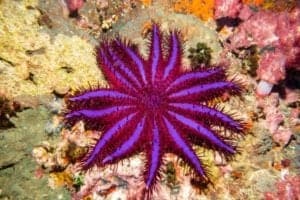Starfish seem like pretty unimportant or innocuous creatures, but that’s far from the truth. In the coastal areas where starfish live, they are foundational for the ecosystem and help break down waste, act as food sources, and are key for healthy marine ecosystems. Recently, a massive decline in starfish numbers has been recorded, causing rising levels of worry in science communities, but strange crossbreeding across species may be the key to helping them survive. Let’s learn more about this strange occurrence, and why it might be happening in the first place.
A Decreasing Starfish Population

Starfish wasting disease is decimating coastal populations across the California coast.
©Raul Baldean/ via Getty Images
The once-thriving populations of starfish along the Pacific Coast are facing a dire threat: sea star wasting disease. It’s not a pretty sight, either: skin lesions progress to limb loss and ultimately turn them into puddles of biomass on the sea floor. Since its emergence in 2013, scientists have labeled it the most significant disease epidemic ever observed in wild marine animals.
Scuba divers, who once encountered dozens of starfish in their underwater explorations, now report finding none. While the disease itself is a natural occurrence, recent research suggests that climate change has played a role in intensifying its impact. Rising sea surface temperatures, attributed to human-induced climate change, have created warm water patterns that render starfish more susceptible to the disease.
Is it all hopeless for starfish? Thankfully, no. While the Pacific populations of starfish are being threatened, certain trends in the Atlantic population show that the family of related species (starfish more broadly) may be able to adapt in the face of the threat.
Interbreeding May Give Starfish the Resistance they Need
In some good news, the sexual exploits of some excitable starfish may just be the thing that saves the species! The discovery of starfish interbreeding could hold the key to their survival while facing growing threats like sea star wasting disease and changing climate conditions.
What exactly is this interbreeding? Well, it turns out that when scientists examined starfish genes, they found something unexpected. Starfish from different species were coming together and mixing their genetic material. This was mostly observed along the coast of Maine in the United States.
What’s particularly intriguing is how these starfish are adapting to their environment. Some starfish species are adapted to specific conditions, while others have a broader habitat range. When they interbreed, they create starfish with a blend of traits from both parents.
When they start interbreeding, it becomes clear how this all matters: climate change is causing the ocean to warm up, making starfish more vulnerable to diseases like sea star wasting disease. But these interbred starfish might be onto something. By combining genes, they could be developing new ways to survive. Using genes like a little toolbox, they’re creating combinations that could make them better equipped to deal with disease or adapt to the warmer waters caused by climate change.
In essence, this interbreeding among starfish isn’t just something interesting for humans – It’s a clever survival strategy. Starfish are adjusting to some pretty threatening challenges in their environment by mixing and matching their genetic tools, and this could ultimately help them survive in a changing ocean.
The Importance of Starfish in an Ecosystem

Certain species of starfish are interbreeding and gaining the ability to survive in more variable water conditions.
©Damsea/Shutterstock.com
While starfish may appear unassuming, they play a pivotal role in maintaining the health of coastal ecosystems. Their significance becomes even more clear as their numbers plummet across key regions in the United States and abroad.
At their core, starfish are basically nature’s clean-up crew along coastlines. They help break down organic matter, turning it into nutrients, in turn keeping coastal waters clean and reintroducing essentials. In many ways, they are like the maggots and bacteria of the ocean, preventing dead creatures and materials from piling up. Think of them as the janitors of the ocean.
Even more, starfish occupy a crucial position in the marine food web. They are a primary food source for various marine creatures, including birds, fish, and sea otters. Many things eat starfish!
Because of all this, starfish are considered “keystone species.” This means that their presence or absence has a disproportionate impact on the overall structure and stability of an ecosystem.
However, the decline in starfish populations, driven by factors such as sea star wasting disease and changing climate conditions, has raised alarms among scientists. The loss of these keystone species can trigger a cascade of negative effects throughout the ecosystem. For instance, without starfish to keep them in check, sea urchin populations explode, leading to overgrazing of kelp forests. This damages the habitat of countless marine species while also reducing biodiversity.
Starfish are far from insignificant creatures. They are essential components of coastal ecosystems, contributing to cleanliness, biodiversity, and overall ecosystem health.
Thank you for reading! Have some feedback for us? Contact the AZ Animals editorial team.








